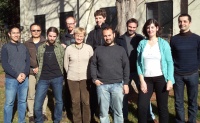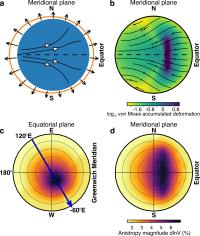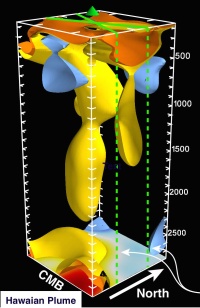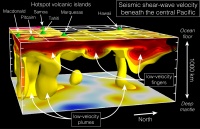Main Page
OPENINGS
WHO WE ARE & WHAT WE DO
|
The Global Seismology Research Group resides at UC Berkeley, within the Department of Earth and Planetary Science and the Berkeley Seismological Laboratory. Our research focuses on structure and dynamics of the deep earth, from the crust to the inner core. We tackle theoretical wave propagation problems in complex 3D media, including forward modeling and full waveform tomographic inversion (FWI) for elastic as well as anelastic structure. In order to better understand the chemical and thermal state of the mantle and the processes operating therein, we seek to apply the latest findings of the mineral physics community within the context of our seismic probing. We also study earthquake source mechanisms and scaling laws, as well as global seismic moment release and its relation to plate tectonics. One of our recent research directions concerns the Earth's "hum" and the insights it brings to ocean/atmosphere/solid earth interactions. Another one is "Box Tomography", i.e. how to perform FWI of remote target regions in the deep earth while keeping the computational cost manageable. Our research is supported through a variety of sources, mostly through grants from NSF. |
 |
 |
 |
 |
RECENT HIGHLIGHTS
 |
2021: Dynamic history of the inner core constrained by seismic anisotropy: The inner core is seismically anisotropic with P-waves travelling along the rotation axis slightly faster than in the plane of the equator. This anisotropy is known to be stronger in the west then in the east and has previously been parameterised as being separated into distinct, sharply-bounded hemispheres. Using new data, in combination with 20 years of observations from the Berkeley catalogue, we found instead that the strength of anisotropy smoothly increases with depth into the inner core, and that the strongest anisotropy is offset into the western hemisphere. We built a combined geodynamic and mineralogical model of the inner core that suggests that the observed pattern of anisotropy results from growth of the inner core that is faster at the equator than at the poles, and faster in the east than in the west. Our model has implications for the viscosity, age, and heat flux of the inner core, and thus the geodynamo. This work was published in Nature Geoscience in 2021." |
 |
2018: Building from our 2014/2015 whole mantle radial anisotropy model SEMUCB_WM1 (see below), we have developed a 3D global shear attenuation model SEMUCB_UMQ, the first one to be based on accurate forward wavefield computations using the Spectral Element Method. The construction of this model by full waveform inversion of 3-component long period waveforms (including fundamental mode and overtone surface waves) followed an iterative approach where the 3D elastic and anelastic structure were alternatively updated. Find abstract, codes to read and plot the model, and related papers here |
 |
Find abstract, codes to read and plot the model, and related papers HERE |
 |
2013: Applying a new waveform imaging methodology that takes advantage of accurate numerical seismic wavefield computations, Barbara Romanowicz's group has constructed a global shear velocity model in the upper mantle that reveals the presence of low velocity channels at the base of the oceanic asthenosphere. In a paper recently published in Science (http://www.sciencemag.org/content/342/6155/227.full), graduate student Scott French, former graduate student Vedran Lekic (now assistant professor at the University of Maryland) and Barbara Romanowicz show that these quasi-periodic finger-like structures of wavelength ~2000 km, stretch parallel to the direction of absolute plate motion for thousands of kilometers. Below 400 km depth, velocity structure is organized into fewer, undulating but vertically coherent, low-velocity plume-like features, which appear rooted in the lower mantle. This suggests the presence of a dynamic interplay between plate-driven flow in the low-velocity zone, and active influx of low-rigidity material from deep mantle sources deflected horizontally beneath the moving top boundary layer. Hotspots are not the direct consequence of plumes impinging on the lithosphere. Find abstract, codes to read and plot the model, and related papers HERE |
NEW CHANGES
New changes to this wiki site can be found here.
